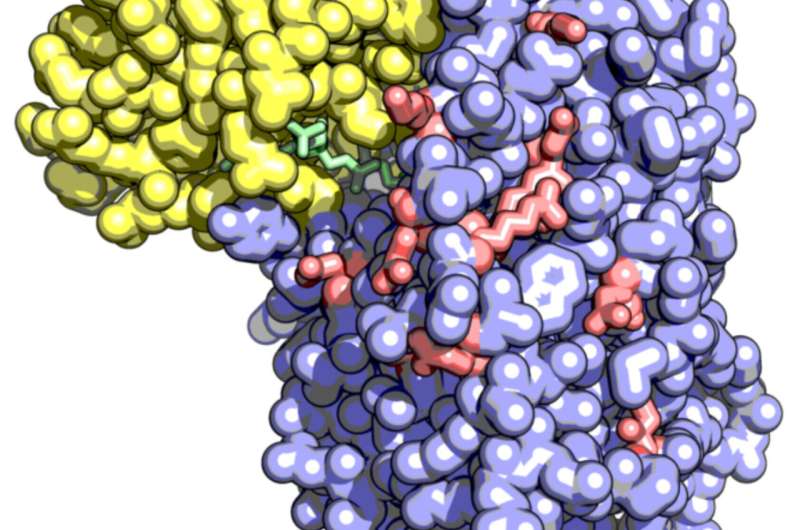This article has been reviewed according to Science X's editorial process and policies. Editors have highlighted the following attributes while ensuring the content's credibility:
fact-checked
peer-reviewed publication
proofread
Tailored enzymes open new possibilities for improving the smell of fish protein powders

Biotechnology offers the opportunity for seafood producers to better exploit their byproducts. By using tailored enzymes, Biotechnologists at NORCE have improved a protein powder made from fish byproducts.
Enzymes, in essence, are catalysts. They increase the rate of a chemical reaction, without being consumed themselves. They can be incredibly precise and selective in which reactions they catalyze. However, many enzymes are quite sensitive to temperature, and lose their activity at around 40°C or above.
In a project preceding this new study, called aMASE, researchers found an enzyme that could remove a molecule that causes fish smell. Taking their research one step further, the group recently published an article in the journal Applied and Environmental Microbiology demonstrating an enzyme variant called mFMO_20, which has been improved by making it more heat resistant.
"We started with an enzyme which is an efficient catalyst, but unable to tolerate high temperatures. Now, we have an enzyme which works better under processing conditions. We hope such an enzyme will be of interest to seafood producers who wish to exploit their byproducts even better, to increase their profitability," says researcher Rasmus Ree.
The work has been done under the EU project OXIPRO. Ree is a co-author of the study, which was performed in collaboration with researchers at CSIC in Madrid. The other NORCE researchers involved in the new study are Marianne Goris, Pål Puntervoll and research director Gro Bjerga.
"Our ambition is to design an enzyme process which seafood producers can use to make their business more profitable, and to keep as much of the biomass as possible food-grade," Ree says.
When fish are butchered they are usually fileted, and while the filet is sold, the rest of the fish carcass remains in the form of a head, frame and guts. These byproducts represent a large fraction of the total biomass. Much of this biomass is in the form of proteins with excellent nutritional value, which could have a higher economic value if they were more suitable for food.
"The way these byproducts are handled now is that they are ground and treated with a special type of enzyme, called a protease. A protease cuts the fish proteins into smaller pieces. This process is called enzymatic hydrolysis, and what we are left with is a hydrolysate. After the hydrolysis is complete, the proteins are dried and you are left with a protein powder," says Ree.
Protein shakes for athletes, or meal replacements for the elderly
"This protein powder naturally tastes and smells like fish, and for that reason, it is not used much for human food. Instead, it is used for animal feed and pet food. If we could make a protein powder with a neutral flavor, we could use it for things like protein shakes for athletes, or meal replacements for the elderly or others who have trouble getting enough high-quality nutrition. This is more economical and more environmentally sustainable than taking it out of the food chain for other purposes," says Ree.
For this reason, the purpose of this project has been to find an enzyme which not only removed the fish smell, but also can work in an industrial process which takes place at a relatively high temperature.
"We know that a compound called trimethylamine (TMA) causes a large part of the fish smell. So the strategy we have chosen is to use an enzyme which converts TMA into trimethylamine-N-oxide (TMAO), as TMAO is smell-free. TMAO exists in fish naturally anyway. In fact, the TMA gets into the hydrolysate because after the fish is butchered, bacteria convert the naturally occurring TMAO into TMA."
Structure of the enzyme variant
In 2020, Bjerga's research group published a study showing that a natural enzyme called flavin-containing monooxygenase (mFMO), isolated from a methane-consuming bacterium, can be used to convert TMA into TMAO in a fish protein hydrolysate.
"The hydrolysis process happens at a quite high temperature, 50°–60°, for hygiene reasons. mFMO is not stable at that high a temperature. We made some changes in the mFMO enzyme, using an advanced algorithm which takes the shape and properties of the enzyme into account and suggests modifications we can do to make it more heat resistant," Ree says.
In collaboration with researchers at CSIC the NORCE scientists solved the structure of this enzyme variant. The molecular structure of an enzyme can tell us a lot about its function, and in this case, they could see that the variant had some small but consequential changes in its surface, which could explain why it could handle the increased temperatures.
"In the end, we were able to show that we can use the improved enzyme in a hydrolysate made from salmon protein. When we increased the heat up to the process temperature, only the new enzyme variant could perform. Not only that, but it worked better at a higher temperature than at a lower one! This told us that the new enzyme variant can handle industrial process conditions. Now we want to test it on other raw materials, such as cod and pelagic fish, while we continue optimizing the enzyme," Ree says.
More information: Marianne Goris et al, Increased Thermostability of an Engineered Flavin-Containing Monooxygenase to Remediate Trimethylamine in Fish Protein Hydrolysates, Applied and Environmental Microbiology (2023). DOI: 10.1128/aem.00390-23
Journal information: Applied and Environmental Microbiology
Provided by NORCE



















